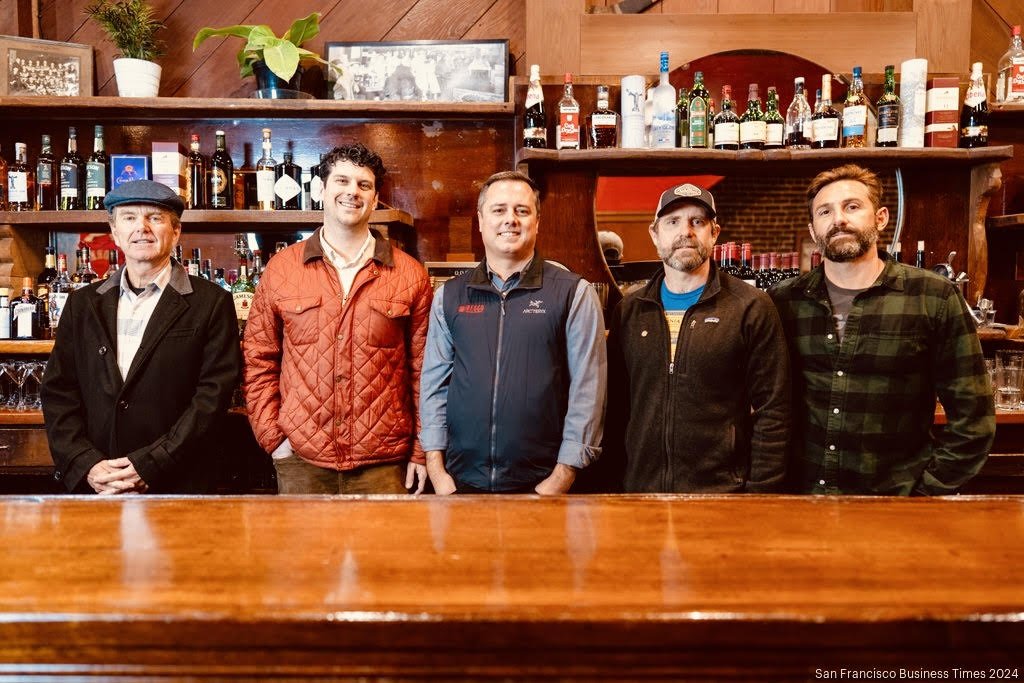For generations, workers trod a path through downtown to Harrington’s bar — longshoremen near the waterfront, grocers in the Produce District and more recently magazine editors and real estate brokers working in the high-rises that sprang up around the low-rise building at 245 Front St.
Lately, those feet have been scarcer. Foot traffic is half what it was in 2019. And with the city’s Financial District in tough straits, there have been no shortage of ideas to revive it: everything from light shows to drag brunches, bakeries and tailor shops, the conversion of older buildings into housing.
The pandemic and the chaos it unleashed into financial markets and work culture have forced a reset on downtown, along with the trading of buildings into new hands with divergent plans. But the fate of the longtime Irish pub on Front Street may be different: New owners plan to reopen Harrington’s Bar & Grill in time for St. Patrick’s Day.
It joins a range of buzzy hospitality and retail investments in the northern Financial District, like Tyler Florence’s new Wayfare Tavern on Pine Street and another Osha Thai on Montgomery. But the reopening of Harrington’s — shuttered since October 2020, with fitful efforts to revive it since then — promises more than a nostalgia play.
The historic bar’s resuscitation is a reminder that downtown San Francisco needs more than a how and a where. It needs a why.
Saving a piece of downtown history
For Henry Harrington, the Irish immigrant who opened the business in 1935, the why at the time was straightforward enough: The repeal of Prohibition and the busy wharves of San Francisco made for a place where he could set up a pub like the one he ran back in Ireland’s County Cork.
His great-grandson Ken, who tended bar when he wasn’t teaching math at the University of San Francisco, and the rest of the family had been searching for a buyer or long-term lessor to pass the torch to since the bar closed in 2020. They had serious interest from a dozen possible buyers, with plans ranging from total redevelopment to partial preservation. One proposed a trendy hookah bar.
But the Harringtons settled on Chris and Jason Freise of Redco Development, who partnered with Ben Bleiman and Duncan Ley of Tonic Nightlife Group. Tonic will operate the bar and helped secure an SBA loan and insurance for the new business.
It helped that the Freises had a “100% Irish” grandmother who gave St. Patrick’sDay a holy place on the family calendar. The group signed a lease with an option to buy the business and the 10,000-square-foot building for a set — but undisclosed — amount.
What the Freises didn’t offer was the highest price. That didn’t matter, Ken Harrington said. The family had an offer to sell the business in the 1950s for “three times what it was worth.” They passed then, too.
In a part of town ostensibly dedicated to making money, it turns out that there are still some who value history, heart and hard work more.
“We really did make a decision not to go for the money,” Ken said of himself and his father Robert, both with decades behind the bar. “They are truly good people, care about San Francisco and will bring Harrington’s back to its glory days. We really have enjoyed the four years getting to know them. They get it.”
Redco and Tonic aren’t the only investors. A cohort of roughly 150 friends and longtime patrons, with many times more Harrington’s memories between them, contributed a crucial portion of startup capital for the investment. It’s telling that many hail from the commercial real estate community and were themselves coming off of not-so-stellar years themselves, but felt compelled to pitch in.
“We wanted to keep it all,” Chris Freise said. “We want to not only invest with our patronage but our wallets and say, ‘This stuff is worth saving.’”
It’s those stories, traded across the bar, that animate Harrington’s legacy. It’s the lore — like the stories of Henry dodging bullets in the 1920s as he escaped Ireland for France in a fishing boat with his son Leo, on his way to San Francisco via Canada and Montana.
When the first Harrington’s on U.S. soil opened in 1935, Henry enlisted Leo (now of legal age) to tend bar and drive a truck along the shoreline to pick up thirsty longshoremen from the nearby docks. A motto on an old Harrington’s matchbook captures the vibe: “You’re a stranger here but once,” it reads.
As the area that’s now the Financial District evolved from its blue-collar origins, so did the crowds at Harrington’s. It became a staple for the surrounding offices. In the early 2000s, one magazine based in a nearby office tower sent reporters there in search of editors on deadline. More recently it cemented the loyalty of the commercial real estate community, some of whom made the leap from barflies to benefactors in this latest chapter.
A reason to stick around
Tonic brings to the table a long track record of opening and managing San Francisco bars such as Soda Popinski’s, Bullitt, Tonic, Teeth, Rebel, Royal Tug Yacht Club, Wild Hare, Lightning Tavern and Cease & Desist. The pair have been outspoken advocates for the local industry through the SF Bar Owner Alliance, playing an influential role in local city policy on nightlife businesses.
Bleiman, a longtime representative for bars on the city’s Entertainment Commission, feels strongly that downtown San Francisco’s path back to relevance must involve more opportunities for nightlife and events.
Policy observers generally agree that in the long run, the path to more foot traffic downtown will require more people living in or closer to the urban core — a strategy which helped revive Wall Street in the 1990s. But in the meantime, this part of town can do a lot to help itself by giving people a reason to make the voyage besides work, or to stick around after hours.
“We absolutely cannot bring downtown back unless it is fun,” Bleiman said. “And we can’t sit back and wait for others to do it for us. That’s why we’re doing this still and I believe it’s going to happen.”
To keep the bar at least symbolically in the family, Redco and Tonic awarded stakes to four remaining family members: Ken; his wife Sherri; and two now-grown children of Ken’s uncle Mike, Patrick and Siobhan.
In mid-December, after the ink had dried on the deal, Harrington’s hosted a private Christmas party for more than 400 people — a preview of the kind of lively revelry that could come back to the corner this March.
Patrons can expect a revamped interior decked in a near-century’s worth of pub lore. In the opening weeks, a “story night” series will bring Harrington’s legends to the mic to share their tales and christen the bar’s new chapter. They’ll include some longtime employees who were recently rehired.
And who knows what other special guests might pay a visit? Over the years, Harrington’s became a mecca for 49ers fans. But it was also favored by the team itself.
Ken recounted one packed Friday afternoon in the 1980s when, around 4:30, he got a call from someone who claimed to work for team owner Eddie DeBartolo Jr. Could Harrington’s host a group of 30 in an hour?
“Are you for real?” Ken recalls asking from the bar, seeing scant space for dozens of 49ers. Nevertheless, right on time, a limousine pulled up and disgorged Joe Montana, team executive Carmen Policy, DeBartolo and their entourage.
“I go up to the round table and I interrupt and ask everyone, ‘Hey, can you work with me here? Can you clear out?’” Ken said. “And they go, ‘This is frickin’ amazing!’ and they do.”
It’s those stories, traded across the bar, that animate Harrington’s legacy. It’s the lore — like the stories of Henry dodging bullets in the 1920s as he escaped Ireland for France in a fishing boat with his son Leo, on his way to San Francisco via Canada and Montana.
When the first Harrington’s on U.S. soil opened in 1935, Henry enlisted Leo (now of legal age) to tend bar and drive a truck along the shoreline to pick up thirsty longshoremen from the nearby docks. A motto on an old Harrington’s matchbook captures the vibe: “You’re a stranger here but once,” it reads.
As the area that’s now the Financial District evolved from its blue-collar origins, so did the crowds at Harrington’s. It became a staple for the surrounding offices. In the early 2000s, one magazine based in a nearby office tower sent reporters there in search of editors on deadline. More recently it cemented the loyalty of the commercial real estate community, some of whom made the leap from barflies to benefactors in this latest chapter.
A new, old story
Robbie Silver, who leads the community benefit district encompassing the Financial District and Jackson Square, is tired of the narrative that downtown is doing nothing but bleed retail businesses.
The executive director of the nonprofit Downtown SF Partnership has spearheaded activation efforts designed to make the area a place workers will want to linger after the office or bring their families on weekends. One recent event — a free, first-of-its-kind holiday light show projected onto downtown skyscrapers themselves — drew more than 67,000 people and an estimated $8 million in related spending.
Depressing headlines about office leases and big-box store closures, he said, ignore a trend towards fewer vacancies at the pedestrian level. Silver said an upcoming report from his group may show there have been more ground-floor openings than closures over the last two years in his district. For now, he offered this nugget: his group counted 17 new tenants filling empty ground-floor spaces in 2023, primarily food and beverage spots that may indicate renewed demand.
Silver is a fervent believer in the need for creativity and an embrace of San Francisco’s unique character as the route to a more dynamic downtown. This summer will see the return of his group’s “Drag Me Downtown” series, consisting of free pop-up performances from local drag queens, kings and trans artists across downtown bars. But the unique spirit also includes places as unsequined as Harrington’s.
“I think it’s time for San Francisco to tell a new, old story,” Silver said.
That’s why the choices of downtown’s longtime property owners like the Harrington family will become especially important over the next few years. The diverse collection of family and institutional owners spent the pandemic waiting out an uncertain market. And by the looks of a lot of empty ground floors downtown, some appear content to keep on waiting until the perfect tenant or building buyer comes knocking.
Property owners will need to decide if their next move will be strictly about dollars and cents or if there’s room for something else in their calculations — like the spirit that kept the Harringtons going.
Ken recalled hosting his great-grandfather Henry, then in his 80s, at the bar shortly before the pub’s founder passed away.
“He was so happy that I, a Harrington, was working there,” he said. “And he would be so happy that we took this so deep, to nearly 100 years.”
From Left to Right: Ken Harrington, Patrick Harrington, Chris Freise (REDCO), Ben Bleiman (Tonic) and Duncan Ley (Tonic)




